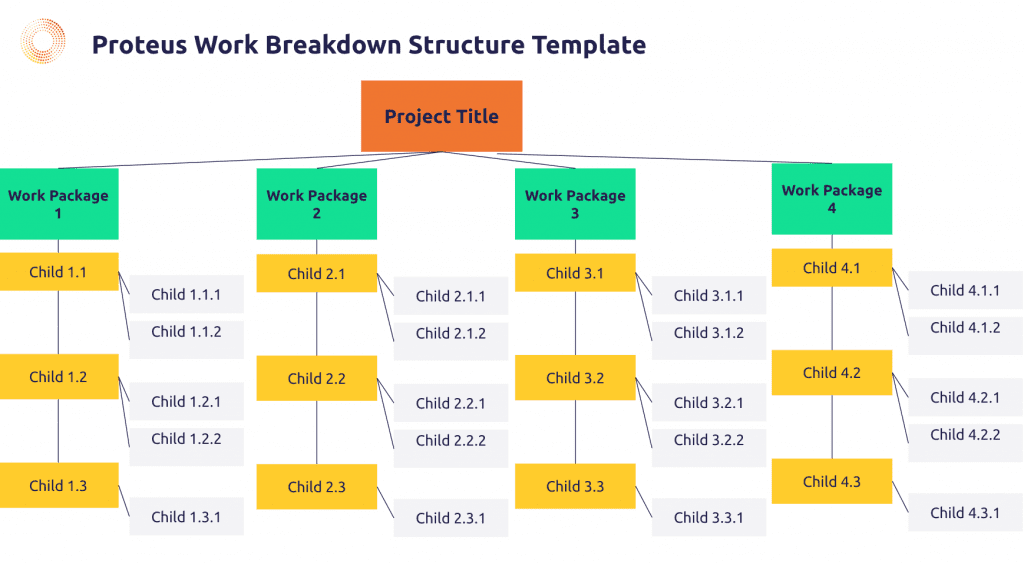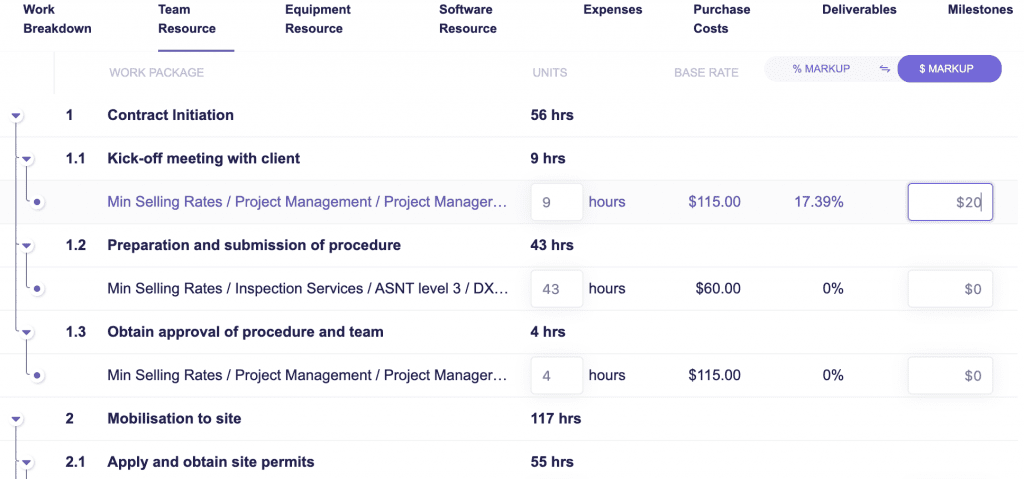…and why do all project teams need one?
A work breakdown structure is a way to organize project work for easier project management planning and control. It helps break down the work into manageable parts. This structure makes it easier to plan and control the project.
Whether you work in construction, infrastructure, energy, mining, or any other large capital investment industry, a work breakdown structure is an essential tool for effective project management.
- So what is a work breakdown structure?
- Importance of allocating resources to a project
- How to use a work breakdown structure in Proteus to manage resources
- How to use Proteus to create WBS for project proposals or plans
- Tips for avoiding common pitfalls when creating a work breakdown structure
- How a WBS fits in with an effective project management strategy for a positive impact on business performance.
- About Proteus Project Software
- How to get Proteus
Work breakdown structures might not be a part of your company’s common language for managing projects. If you’re a project or resource manager, you might be reading this blog to find project management terms you’re familiar with. The term ‘work breakdown structure’ may not be used in your business. However, if you work on a project team, it is something you probably use daily, albeit under a different name.
The standout feature of the Proteus project management tool is the unique way in which it manages the work breakdown structure.
Sometimes referred to as cost, time, and resources (CTRs), or simply a ‘task list’ the whole genius behind a work breakdown structure is the way it allows a project manager to add detail at a very granular level to an extremely complex series of activities that are required to meet the project objectives. In this blog, we look at the definition of ‘work breakdown structure’, its benefits, some common pitfalls, and how project managers can use a work breakdown structure in Proteus to ensure project success.
So what is a work breakdown structure?
The Project Management Institute (PMI) defines WBS as “a deliverable-oriented hierarchical decomposition of the work to be executed by the project team to accomplish the project objectives and create the required deliverables.”
By breaking a project down into smaller, more manageable tasks, or work packages, a WBS helps to ensure that all scope and objectives are met while keeping costs and resource allocation under control.
The key to a WBS is its hierarchical tree composition, which sorts and organises project objectives into deliverables and activities. Each new level in the WBS represents a new and increasingly detailed definition of work, with the lowest level representing the individual tasks that need to be completed.
This structure ensures that we include all the necessary work in each task and do not leave out any task. It helps with planning and control and can be used in different project management methods like Lean, Agile, and Waterfall.
There are various different ways to organise a work breakdown structure visually: in a flowchart, a list with sub-tasks, or a Gantt chart. Proteus uses a combination of all, representing a diagrammatic list with spreadsheet functionality and a Gantt chart. This work breakdown structure template enables close control of even the most complex deliverable-based projects.

Perhaps most importantly, a WBS provides a clear framework for team communication and coordination. Without a WBS, project team members are more likely to duplicate effort, overlook key objectives, or exceed their budgets. In short, a well-constructed WBS can make the difference between project success and failure.
When used correctly, the WBS is a powerful tool for ensuring that all stakeholders are on the same page and that projects are completed on time, on budget, and to the required standards.

Importance of allocating resources to a project
Critical to the success of any project, at the planning or proposal writing stage, project managers need to ensure that resources are allocated effectively and efficiently. Proteus allows you to distribute resources and all their costs and margins over the full span of the project at the planning stage. Any successful project depends on a baseline allocation whereby resources are plotted against tasks over time to form a baseline. This baseline serves as the reference point against which the project data can be measured during project execution.
Resources can be anything required to perform tasks- team members, software, equipment, facilities, materials, and even costs. When planning resources in Proteus we catagorise these into three main resource types: team, equipment, and software. The WBS provides a detailed overview of the work that needs to be done, and milestones help to keep the project on track, and the resources needed to complete the work- this is the baseline.
Deadlines help to ensure that work is completed on time, and costs need to be carefully monitored to avoid overspending. Because Proteus has been designed to take project teams away from clunky, disconnected spreadsheets, much of the functionality will feel familiar to users. Allocation of resources can be distributed and adjusted using drag-and-drop tools and other easy-to-use features.

How to use a work breakdown structure in Proteus to manage resources
To make a good WBS, each main task must have multiple subtasks to be considered finished. This rule ensures that every task is properly accounted for and that no work is missed. By following this rule, you can create a well-defined and effective WBS for your next project.
To create a WBS, start by identifying the main deliverables for the project. Then, break each deliverable down into smaller tasks, assigning the required resources to each. Finally, create a timeline for each task, taking into account any dependencies.
Using a project management tool or work management system like Proteus is essential to ensure WBS is created with complete consistency and accuracy across your team. This significantly reduces risk when running multiple complex projects.

How to use Proteus to create WBS for project proposals or plans
Proteus can handle projects as the owner or as a consultancy managing projects for clients. Consultancies need a project management tool like Proteus to help win and then execute projects. Operators need Proteus to ensure they have 100% visibility and control over the projects they run (where the work is often executed by consultancies). Both need Proteus to drive profitability and reduce wastage.
The subtle differences lie in terminology. Consultancies use proposals. Operators use pre-project feasibility plans.
In Proteus, the smaller ‘tasks’ or ‘job cards’ that are added to a WBS are referred to as work packages. (This terminology can be changed to suit your company’s setup.)

To create a work package in Proteus, you need a project proposal or a pre-project plan. The project proposal is for used by teams who bid for work using proposals, for example, project consultancies. The pre-project plan is for operators who focus on project feasibility instead of creating proposals.
In the proposal setup, you create the basic work package and its critical parameters by adding task scope, deliverables, and start and end dates. You can then add child work packages. As many work packages can be added to each proposal with as many levels within each work package as needed.
Costs are created when resources are added, pulling the pre-set rates from the approved contract rate tables. You can add markups to the whole work breakdown or just parts of it, making it easy to manage. After entering quantities and rates, the system will calculate subtotals and totals. You can then include this accurate work breakdown catalogue in your final proposal document.

Once the project has been given the green light, you can pull all the WBS details from the proposal stage into the project management module in Proteus, complete with all the rates and timelines.
Tips for avoiding common pitfalls when creating a work breakdown structure
By making a work breakdown structure, project managers can ensure all work is planned well and deadlines are realistic. This can help to avoid cost overruns and prevent project delays and ensure project profitability. But it is possible to make mistakes when creating a WBS.
One pitfall is failing to align the WBS with the overall project objectives. A WBS should be designed to support the overall goal of the project, so it is important to ensure that it is aligned with the project objectives from the start.
Another pitfall to avoid is failing to involve all stakeholders in the creation of the WBS. All stakeholders should have a chance to provide input on what tasks need to be included in the WBS.
It is also important to avoid scope creep when creating a WBS. This occurs when additional tasks and deliverables are added to the WBS without properly modifying the budget or timeline.
By avoiding these common pitfalls, you can create a well-designed WBS that will help your project run smoothly.
How a WBS fits in with an effective project management strategy for a positive impact on business performance.
The WBS serves as a versatile tool that supports various types of project management solutions. It can help to define the scope of the project, create a timeline for project deliverables, track project progress, and identify waste. The WBS can be used with other tools to make sure the project is finished on time and within budget.
When used correctly, the WBS can be a valuable tool for both project managers and project teams. It can help to clarify project objectives and ensure that all stakeholders have a common understanding of the project scope.
Additionally, the WBS can help project managers to plan project phases and control project progress, as well as identify potential risks and issues. When used properly, the WBS can be an effective tool for managing even the most complex projects whether run on lean, agile, waterfall or any other project management methodologies.
For example, in agile project management, the WBS is used to define the scope of the project and to create a timeline for the project deliverables. In waterfall project management, the WBS is used to create a project schedule and to track project progress. The WBS can also be used in lean project management to identify waste and to improve process efficiency.
Ultimately, a WBS is a way to help ensure teams are equipped to plan and execute a series of activities, driving up project profitability, and directly improving business performance.

About Proteus Project Software
Xergy Group’s Proteus project management software is designed to work with your existing systems and to scale and evolve as your business grows. Created by project management leaders, for the diversified engineering consultancy sector, Proteus delivers an end-to-end work management software platform with detailed workflows from the early opportunity stage through to project delivery.
Proteus’ end-to-end project management software is a cloud-based system designed for businesses of all sizes to handle projects of unlimited complexity and is compliant with common project management frameworks and ISO standards. Each feature is aimed at making bottom-line improvements by improving utilisation, streamlining workflows, providing quick and efficient access to resources, and reducing overheads. Check out some of our client case studies to learn more about how Proteus makes a tangible difference.
How to get Proteus
We recommend getting setup on a free trial. Proteus operates under a software-as-a-service (SaaS) model. We offer Enterprise packages and flexible pricing solutions: contact our team to learn more.
We designed Proteus to be simple, and that means you can get up and running on Proteus without an IT team or support from a programmer. You will want to spend a bit of time configuring the admin console so that you have everything set up to suit your company structure, but it’s very intuitive and you don’t need a PhD in IT. However, we want you to get the best out of what is a brilliantly powerful tool, so don’t hesitate to ask for our support. We have a team of product experts who are ready to help you with the configuration process, so get in touch today by filling out the form below:



